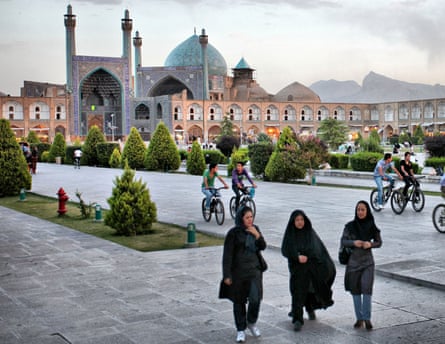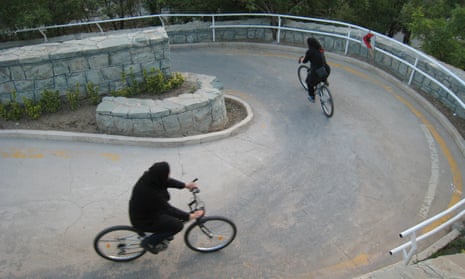It’s a hot spring day in Tehran, and Negin, a 32-year-old IT manager, is riding her mountain bike through a park. “I love my bike. I often go cycling in the countryside with a group,” she says. “I also cycle in the city, when I go to visit my mother, for example. I think the number of women cycling in Tehran is growing. I even have a friend who goes to work on her bike. I would love to do that, but it’s too far and we don’t have showers at work.”
What Negin is saying might not sound strange, if it weren’t for the fact that she’s a woman, on a bike, in the Islamic Republic of Iran. In spite of the heat, Negin is conforming to the dress code – she wears long sleeves and leggings, a headscarf under her helmet and a skirt covering her hips – but religious leaders at the highest level in Iran are clear: women on bikes constitute a threat to morality.
The question has become a hotly debated point in Tehran in recent months, as the city grapples with two truly dire problems: air pollution and traffic congestion, both some of the world’s worst. With cars choking Iran’s cities, campaigns to encourage cycling are picking up speed.
In autumn of 2015, a young environmentalist in Arak, a city with pollution levels even more staggering than Tehran, started a “car-free Tuesday” campaign to encourage people to commute by bike. The campaign caught on, and other cities followed suit. Municipal authorities across the country began encouraging residents to ride bikes and leave their cars at home.
Women cyclists, naturally enough, saw an opportunity to support a good cause that everybody in Iran could agree on: clean air. After all, there is no law in Iran that officially forbids women to cycle.

But when women in Marivan, a city in west Iran, took to their bikes, they were arrested by police – despite having explicitly followed the advice of the local authorities to cycle instead of drive.
They were released the same day, but only after signing pledges to not ride bicycles again. Marivan residents later protested in an open letter to local authorities.
Shortly afterwards, Iran’s vice president for women’s affairs, Shahindokht Molaverdi, posted a photograph of women cycling on her official Twitter account. Under it, she quoted the country’s supreme leader, Ayatollah Ali Khamenei, as saying: “Women’s cycling is permissible on the condition that religious customs are observed.”
Subsequently, in an article in the pro-government Tehran Times, a female journalist quoted a government official who supported female cyclists, and concluded: “As long as there is no violation of the dress code, women should be free to ride bicycles on the street.”
Hopes, however, were crushed when Khamenei issued a fatwa in September 2016, stating women were allowed to ride bikes – just not in public.
The fatwa sparked a reaction from female cyclists, who posted photographs on social media of themselves on their bikes, with the hashtag #IranianWomenLoveCycling.
This article includes content provided by Instagram. We ask for your permission before anything is loaded, as they may be using cookies and other technologies. To view this content, click 'Allow and continue'.
Among them were a mother and a daughter who posted a short video of themselves cycling on the island of Kish: “Cycling is part of our lives. We were here when we heard Khamenei’s fatwa banning women from cycling. We immediately rented two bicycles.”
Another woman posted a photograph of herself on a mountain bike: “When I was a child, my parents did not buy me a bicycle. They said a girl does not ride a bicycle. But I did not give up. I would jump on my youngest brother’s bicycle and ride it in small [alleys], even competing with other boys … I tell this story for those who think [they] can ban us from doing the sports we mostly enjoy with rumours and threats. We will not give up easily!”
As with many things in Iran, the words of the ayatollah may be open to interpretation, according to a woman who is actively involved in women’s cycling. She prefers to remain anonymous, not wanting to be associated with the hashtag campaign.
“You have to see the ayatollah’s words in a context,” she said. “What he said was never official, it was never mentioned on his official website and therefore it doesn’t have the power of a law. I believe that what he meant was that cycling is bad for women only when it has bad moral consequences. As long as women cycle in such a way that it doesn’t have bad moral consequences, it’s OK. This means they need to always wear long pants and long sleeves, a hijab under the helmet, and a skirt. As long as they adhere to these rules, I think there is no problem.”
This article includes content provided by Facebook. We ask for your permission before anything is loaded, as they may be using cookies and other technologies. To view this content, click 'Allow and continue'.
She explains that it generally depends on the local religious authorities whether women are allowed to cycle. “In very religious cities, it is out of the question. But in other places, cycling women won’t get arrested.”
Many Friday mornings, the road around the Tehran Azadi stadium is used as a cycling track. Aficionados in racing gear meet in front of the stadium, including a number of women. Fariba, 36, an accountant who rides a bright yellow bike, grins broadly when asked what it’s like to cycle in Tehran as a woman. “I think it’s exciting,” she says. “And yes, I cycle through Tehran, no problem. I am not afraid of the police.”
Nanaz, 30, a lawyer, describes cycling as her great passion. “I cycle every day. Sometimes I cover stretches of 80km.” She says she has never encountered problems while cycling in the capital. “As long as [the moderate Hassan] Rouhani is our president, we will be able to do it. My great ambition is to take part in the Olympics.”
Whether Nanaz ever makes it there remains to be seen. Although male Iranian cyclists are having some success in Asia-wide competitions, the Iranian Cycling Federation barely has 100 female members. Iranian women are present in all branches of the sport, but during the big tournaments it is generally Chinese and Japanese women who win.
This article includes content provided by Facebook. We ask for your permission before anything is loaded, as they may be using cookies and other technologies. To view this content, click 'Allow and continue'.
Despite the enthusiasm, cycling still has a long way to go before being a serious mode of transport in Tehran. Motorists are largely unaware of cyclists, and the infrastructure is such that in most of the city it is extremely dangerous to be on a bike. The city’s many hills don’t make matters easier.
Iran does have a cycling tradition, though. The bicycle was a popular means of transport in the first half of the 20th century, when cars were an imported luxury that few could afford. When Iran started manufacturing cars on a massive scale in the 1970s, however, the bicycle diminished, and nowadays most Iranians are wedded to their car and regard cycling as something for the poor.
The Tehran municipality has taken a modest steps forward. Bike paths now exist in certain parts of the city, and a bike sharing programme was set up, though it has yet to catch on: few Tehranis were interested in swapping their car for a rented bike, and there were issues with bikes disappearing. A new plan for 120 stations was announced last year – but although the docks have materialised, the bikes have not.
If Iran does have a cycling centre, it would be Isfahan, its astoundingly beautiful “third city”. Here, bikes are everywhere. The city’s infrastructure makes it safer for cyclists than Tehran, and the authorities actively promote cycling. Colourful sculptures of flower-adorned bikes dot the town, and on Tuesdays one of the main thoroughfares, Charbagh Street, is closed to cars for a large part of the day.
Yet although the city’s bike share system is one of the best, with staffed sheds and cheerful blue bikes, there’s still one problem: women are not allowed to rent them.
The guard on duty smiled apologetically and said it wasn’t him who introduced the ban, but remain unmoved by a plea to make an exception for a tourist.
Nevertheless, women can own a bicycle, and you do sometimes see girls cycling across Naqsh-e Jahan Square. “Cycling is really growing here,” said Mahnaz, 29, a female shopkeeper in Isfahan’s busy bazaar. “There are even local politicians who cycle to work to set an example.”
“The biggest problem is not the authorities,” said Negin from Tehran. “It’s the dress code. On warm days, it can get so hot wearing long sleeves and long pants. Even worse are the men who look at you and make remarks. Iranians really have to start getting used to women cycling.”
Guardian Cities is dedicating a week to exploring the future of cycling in cities around the world. Explore our coverage here and follow us on Facebook. Will you be taking our challenge to have conversation with a fellow cycle commuter? Tell us about it here or on Twitter or Instagram using #cycleconvo

Comments (…)
Sign in or create your Guardian account to join the discussion